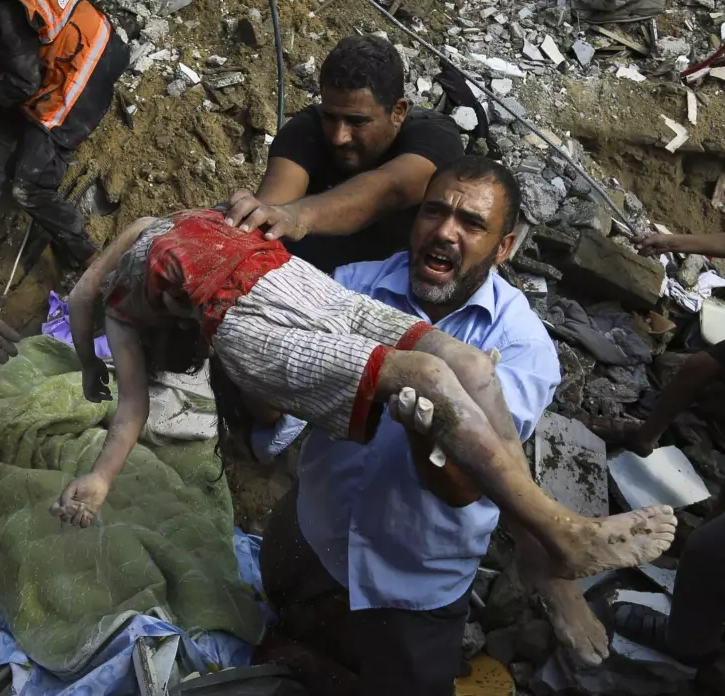Maha Hussaini for Middle East Eye
As Israel’s air strikes on the Gaza Strip continue to claim overwhelming numbers of casualties, civil defence crews find themselves facing two options: spend hours trying to retrieve the bodies, or leave the dead under the rubble and rush to other areas to pull out those who are still alive.
As the Palestinian health ministry counts the thousands of people killed and wounded in Israeli attacks, the civil defence says hundreds are lying dead under collapsed buildings.
With the lack of rescue equipment and the recurrent targeting of its crews, the civil defence told Middle East Eye they are following a plan that gives priority to rescuing victims who are still alive over retrieving the bodies of the dead.
‘We arrive at the targeted place, if we find out that there are people still alive under the rubble, we continue digging until we pull them out. But if we are sure that those who are under the rubble are dead, we leave for another targeted site,’ Khalil Saifan, a civil defence crew member, told MEE.
‘The bombing occurs in different places at the same time, dozens of locations are targeted within 10 minutes, and we have very limited equipment and crew members to act.
‘So we have to choose between spending hours trying to retrieve a number of bodies, or give priority to the wounded trapped under debris before they join the scores of people killed.’
At least 8,000 people have been killed, the large majority women and children, since Israel unleashed a violent bombing campaign on Gaza on 7 October, when Hamas conducted an unprecedented attack on southern Israeli towns. Around 1,400 Israelis were killed and more than 200 people taken hostage.
Saifan, who works at the Gaza Civil Defence headquarters in al-Bureij, in the central Gaza Strip, says there are hundreds of killed residents still under the rubble.
‘Without having to describe the large numbers of casualties in one air strike, you can imagine the scene in a neighbourhood a few minutes after a couple of buildings are knocked down,’ he said.
‘There, we have to give priority to the ones still breathing under the debris. This choice is always made between the dead and the living victims, but never between the living ones.
‘If we know there is someone still alive, it may take us hours to pull them from under the rubble, but we can never leave them there.’
Saifan added that the continued targeting of civil defence crews and the lack of equipment make their attempts to save everyone under the rubble nearly impossible.
‘We have been targeted multiple times and in several areas since the beginning of the offensive. Our crew members are turning from rescuers to victims,’ he said.
‘No country can deal with such a number of air strikes targeting different areas all at once and these overwhelming numbers of victims. Can you imagine this in Gaza?’
The crisis is further exacerbated by the lack of fuel needed for bulldozers, which the civil defence crews rely on to remove the rubble of multi-storey residential buildings and reach the victims.
Still missing
The Palestinian health ministry said it has received at least 1,650 reports from families saying they have missing relatives under the debris as of Friday.
According to Ashraf al-Qudra, the ministry’s spokesperson, around 940 dead children are still under the rubble of their homes or the home their families had sought refuge in.
In the Shujaiya neighbourhood, dozens of residential buildings were knocked down without prior warnings from the Israeli army to evacuate. As a result, entire extended families have been wiped out, and a large number of people are still missing under the debris.
When bombing intensified last week, Amena Mughani’s cousins and their children fled their homes to their sister’s house in Shujaiya, one of the most densely populated areas in the Gaza Strip. Around 30 people were staying in the house when the attack that would destroy it and everyone is in it happened.
‘I can’t remember what day it was, but I do remember that I received a phone call from a relative at noon telling me that the house was flattened and that all my relatives there were killed,’ Mughani, a resident of Gaza City, told MEE.
‘For two days following the attack, their bodies were still not retrieved. The civil defence could not reach their home because it is in the eastern area of Shujaiya, which is very dangerous.
‘I haven’t been able reach my family for the past five days to know if our relatives’ bodies were pulled from the rubble, but I believe they are still there.’
At least 688 families, comprising 4,807 individuals, have been wiped out in Israel’s aerial, artillery, and naval shelling of the blockaded Gaza Strip, according to the health ministry.
‘When the attack is over and we get to recover all the bodies from the rubble, the number of victims will probably be twice the current number,’ Saifan, of the civil defence, said.
